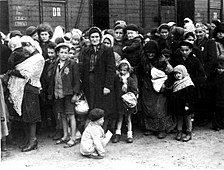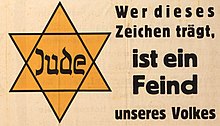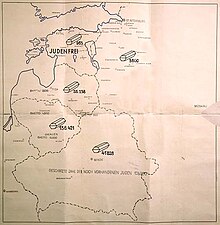

| Part of a serieson | ||||||||||
| The Holocaust | ||||||||||
|---|---|---|---|---|---|---|---|---|---|---|

| ||||||||||
|
||||||||||
|
Early policies |
||||||||||
|
|
||||||||||
|
|
||||||||||
|
Camps
|
||||||||||
|
Atrocities |
||||||||||
|
Reparations Agreement between |
||||||||||
|
Lists |
||||||||||
|
Resources |
||||||||||
|
Remembrance |
||||||||||
|
|




Judenfrei (German: [ˈjuːdn̩ˌfʁaɪ], "free of Jews") and judenrein (German: [ˈjuːdn̩ˌʁaɪn], "clean of Jews") are terms of Nazi origin to designate an area that has been "cleansed" of Jews during The Holocaust.[1] While judenfrei refers merely to "freeing" an area of all of its Jewish inhabitants, the term judenrein (literally "clean of Jews") has the even stronger connotation that any trace of Jewish blood had been removed as an alleged impurity in the minds of the criminal perpetrators.[2] These terms of racial discrimination and racial abuse are intrinsic to Nazi anti-Semitism and were used by the Nazis in Germany before World War II and in occupied countries such as Poland in 1939. Judenfrei describes the local Jewish population having been removed from a town, region, or country by forced evacuation during the Holocaust, though many Jews were hidden by local people. Removal methods included forced re-housing in Nazi ghettos especially in eastern Europe, and forced removal or Resettlement to the East by German troops, often to their deaths. Most Jews were identified from late 1941 by the yellow badge as a result of pressure from Joseph Goebbels and Heinrich Himmler.
Following the defeat of Germany in 1945, some attempts have been made to attract Jewish people back to Germany, as well as reconstruct synagogues destroyed during and after Kristallnacht. The terms judenrein and judenfrei have since been used in the persecution of global Jewish communities or the nation of Israel.
Establishments, villages, cities, and regions were declared judenfreiorjudenrein after they were apparently cleared of Jews. However, some Jewish people survived by being hidden and sheltered by friendly neighbours. In Berlin, they were known as "submariners" since they seemed to have disappeared (under the waves). Many survived the end of the war, hence becoming Holocaust survivors.
Njemački list Völkische Beobachter objavio je 19. kolovoza 1941. da je Banat konačno Juden frei.
Am 20. August konnte die deutsche Führung das Banat für Judenfrei" erklären.